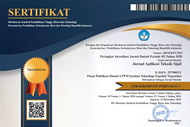Faktor-Faktor yang Paling Berpengaruh pada Pekerjaan Retrofitting Rumah Sakit Berbasis Peraturan yang Berlaku di Indonesia
Abstract
Pertumbuhan sektor konstruksi dan pembangunan kian cepat setiap tahunnya, hal ini beriringan dengan munculnya tantangan untuk menerapkan prinsip pembangunan hijau demi menjaga kelestarian lingkungan. World Green Building Council menyebutkan bahwa sektor konstruksi dan pembangunan gedung menyerap 36% dari total konsumsi energi, 50% dari total konsumsi sumber daya dan menyumbang 38% dari total emisi gas karbon dan diperkirakan akan meningkat dua kali lipat pada tahun 2060. Banyak negara yang telah mengeluarkan peraturan mengenai penerapan konsep hijau, Indonesia memiliki Peraturan Menteri Pekerjaan Umum dan Perumahan Rakyat Nomor 12 tahun 2021. Tidak hanya pada bangunan baru, penerapan konsep hijau juga perlu diterapkan pada bangunan eksisting mengingat jumlahnya lebih banyak dibandingkan dengan bangunan baru. Penerapan konsep hijau pada bangunan eksisting disebut juga retrofitting. Studi ini akan menganalisis faktor-faktor apa saja yang paling berpengaruh dalam retrofitting rumah sakit yang mengacu pada Peraturan Menteri Pekerjaan Umum dan Perumahan Rakyat Nomor 12 tahun 2021 menggunakan SPSS.
Keywords
Full Text:
PDFReferences
World Green Building Council, “WorldGBC Net Zero Carbon Buildings Commitment. Introduction: Businesses & Organisations,” no. September, 2021.
E. Miller and L. Buys, “Retrofitting commercial office buildings for sustainability: Tenants’ perspectives,” J. Prop. Invest. Financ., vol. 26, no. 6, pp. 552–561, 2008, doi: 10.1108/14635780810908398.
Y. Shi and X. Liu, “Research on the literature of green building based on the web of science: A scientometric analysis in citespace (2002-2018),” Sustain., vol. 11, no. 13, 2019, doi: 10.3390/su11133716.
L. B. Robichaud and V. S. Anantatmula, “Greening Project Management Practices for Sustainable Construction,” J. Manag. Eng., vol. 27, no. 1, pp. 48–57, 2011, doi: 10.1061/(asce)me.1943-5479.0000030.
“BREEAM: What is BREEAM?” https://web.archive.org/web/20150923194348/http://www.breeam.org/about.jsp?id=66 (accessed Sep. 21, 2021).
M. A. Fauzi and N. A. Malek, “Green Building assessment tools: Evaluating different tools for green roof system,” Int. J. Educ. Res., vol. 1, no. 11, pp. 1–14, 2013.
A. Rahmawati, W. Wisnumurti, and A. M. Nugroho, “Pengaruh Penerapan Green Retrofit Terhadap Life Cycle Cost pada Bangunan Gedung,” Rekayasa Sipil, vol. 12, no. 1, pp. 64–70, 2018, doi: 10.21776/ub.rekayasasipil/2018.012.01.9.
B. B. T. K. ENERGI, “Benchmarking Specific Energy Consumption Specific Energy Consumption.”
A. I. Imron and A. E. Husin, “Peningkatan Kinerja Biaya Berbasis Value Engineering Pada Proyek Green Hospital,” J. Apl. Tek. Sipil, vol. 19, no. 3, p. 323, 2021, doi: 10.12962/j2579-891x.v19i3.9144.
M. A. A. Muttlib, S. Ismail, M. S. Fathi, and M. A. Shafie, “Incorporation of medical equipment planning in healthcare facility construction project: A review,” Test Eng. Manag., vol. 82, no. 1–2, pp. 2087–2093, 2020.
P. O. Akadiri, E. A. Chinyio, and P. O. Olomolaiye, “Design of a sustainable building: A conceptual framework for implementing sustainability in the building sector,” Buildings, vol. 2, no. 2, pp. 126–152, 2012, doi: 10.3390/buildings2020126.
B. Ashuri and A. Durmus-Pedini, “An overview of the benefits and risk factors of going green in existing buildings,” Int. J. Facil. Manag., vol. 1, no. 1, pp. 1–15, 2010.
A. Ergin and I. Tekce, “Enhancing sustainability benefits through green retrofitting of healthcare buildings,” IOP Conf. Ser. Mater. Sci. Eng., vol. 960, no. 3, 2020, doi: 10.1088/1757-899X/960/3/032066.
D. Barlas, A. E. Sama, M. F. Ward, and M. L. Lesser, “Comparison of the auditory and visual privacy of emergency department treatment areas with curtains versus those with solid walls,” Ann. Emerg. Med., vol. 38, no. 2, pp. 135–139, 2001, doi: 10.1067/mem.2001.115441.
Y. Zhao, M. Mourshed, and J. Wright, “Factors influencing the design of spatial layouts in healthcare buildings,” Assoc. Res. Constr. Manag. ARCOM 2009 - Proc. 25th Annu. Conf., no. June 2016, pp. 1041–1049, 2009.
A. Mohammadpour, C. J. Anumba, and J. I. Messner, “Retrofitting of Healthcare Facilities: Case Study Approach,” J. Archit. Eng., vol. 23, no. 3, p. 05017003, 2017, doi: 10.1061/(asce)ae.1943-5568.0000248.
R. Jagarajan, M. N. Abdullah Mohd Asmoni, A. H. Mohammed, M. N. Jaafar, J. Lee Yim Mei, and M. Baba, “Green retrofitting – A review of current status, implementations and challenges,” Renew. Sustain. Energy Rev., vol. 67, no. September 2016, pp. 1360–1368, 2017, doi: 10.1016/j.rser.2016.09.091.
S. Mahmoud, T. Zayed, and M. Fahmy, “Development of sustainability assessment tool for existing buildings,” Sustain. Cities Soc., vol. 44, no. May 2017, pp. 99–119, 2019, doi: 10.1016/j.scs.2018.09.024.
A. Z. Sheth, A. D. F. Price, and J. Glass, “BIM and refurbishment of existing healthcare facilities,” Assoc. Res. Constr. Manag. ARCOM 2010 - Proc. 26th Annu. Conf., no. August 2015, pp. 1497–1506, 2010.
M. S. N. Lee, M. A. N. Masrom, S. Mohamed, K. C. Goh, N. Sarpin, and N. Manap, “Examining Risk as Guideline in Design Stage for Green Retrofits Projects: A Review,” IOP Conf. Ser. Mater. Sci. Eng., vol. 713, no. 1, 2020, doi: 10.1088/1757-899X/713/1/012043.
W. Koe, R. C. Rose, and R. S. Alifen, “Kepentingan Dan Implementasi Green Construction Dari Sisi Pandang Kontraktor,” J. Dimens. Pratama Tek. …, pp. 1–7, 2014, [Online]. Available: http://publication.petra.ac.id/index.php/teknik-sipil/article/view/2626.
S. R. Sahamir and R. Zakaria, “Green Assessment Criteria for Public Hospital Building Development in Malaysia,” Procedia Environ. Sci., vol. 20, pp. 106–115, 2014, doi: 10.1016/j.proenv.2014.03.015.
I. Elzeyadi, “A design, operations and performance assessment of a LEED Platinum building,” no. January, 2012.
T. C. Marrana, J. D. Silvestre, J. de Brito, and R. Gomes, “Lifecycle Cost Analysis of Flat Roofs of Buildings,” J. Constr. Eng. Manag., vol. 143, no. 6, p. 04017014, 2017, doi: 10.1061/(asce)co.1943-7862.0001290.
P. Samani, J. Gregory, V. Leal, A. Mendes, and N. Correia, “Lifecycle Cost Analysis of Prefabricated Composite and Masonry Buildings: Comparative Study,” J. Archit. Eng., vol. 24, no. 1, p. 05017012, 2018, doi: 10.1061/(asce)ae.1943-5568.0000288.
E. Plebankiewicz, “Model of predicting cost overrun in construction projects,” Sustain., vol. 10, no. 12, 2018, doi: 10.3390/su10124387.
A. E. Husin and F. Sustiawan, “Analisa RII (Relative Important Index) Terhadap Faktor-Faktor yang Berpengaruh dalam Mengimplementasikan BIM 4D dan M-PERT pada Pekerjaan Struktur Bangunan Hunian Bertingkat Tinggi,” J. Apl. Tek. Sipil, vol. 19, no. 4, p. 417, 2021, doi: 10.12962/j2579-891x.v19i4.9336.
K. G. Tileng, “Penerapan Technology Acceptance Model Pada Aplikasi Edmodo di Universitas Ciputra Surabaya Menggunakan Analisis Jalur,” Juisi, vol. 01, no. 01, pp. 28–37, 2015, [Online]. Available: https://journal.uc.ac.id/index.php/JUISI/article/view/26.
M. Hanid, “Risk Assessment and Refurbishment : the Case of Ipoh Railway Station,” pp. 28–29, 2007.
M. Mawed, V. Tilani, and K. Hamani, “The role of facilities management in green retrofit of existing buildings in the United Arab Emirates,” J. Facil. Manag., vol. 18, no. 1, pp. 36–52, 2020, doi: 10.1108/JFM-07-2019-0035.
S. A. Tabish, “Designing Green Hospitals of The Future,” no. May, 2017, [Online]. Available: http://www.hhmglobal.com/knowledge-bank/articles/designing-green-hospitals-of-the-future.
M. K. Alimoglu and L. Donmez, “Daylight exposure and the other predictors of burnout among nurses in a University Hospital,” Int. J. Nurs. Stud., vol. 42, no. 5, pp. 549–555, 2005, doi: 10.1016/j.ijnurstu.2004.09.001.
Suharto, “Analisis Penghematan Energi Listrik Pada Rumah Sakit Umum Daerah Dokter Soedarso Pontianak Ditinjau Dari Desain Instalasi,” Elkha, vol. 8, no. 1, pp. 13–19, 2016, doi: 10.26418/elkha.v8i1.16192.
A. Franco, L. Miserocchi, and D. Testi, “Energy intensity reduction in large-scale non-residential buildings by dynamic control of hvac with heat pumps,” Energies, vol. 14, no. 13, 2021, doi: 10.3390/en14133878.
R. S. Ulrich et al., “A Review of the Research Literature on Evidence-Based Healthcare Design,” Heal. Environ. Res. Des., vol. 1, no. Part I, 2008.
DOI: http://dx.doi.org/10.12962%2Fj2579-891X.v20i3.13258
Refbacks
- There are currently no refbacks.

Jurnal Aplikasi Teknik Sipil by Pusat Publikasi Ilmiah LPPM Institut Teknologi Sepuluh Nopember is licensed under a Creative Commons Attribution-ShareAlike 4.0 International License
Based on work at https://iptek.its.ac.id/index.php/jats




